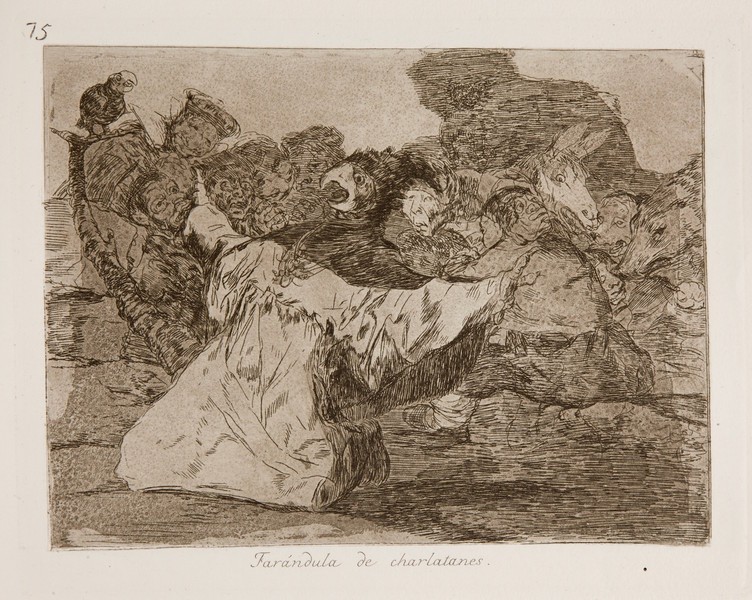- Cronología
- Ca. 1820 - 1823
- Dimensiones
- 177 x 222 mm
- Técnica y soporte
- Aguafuerte, aguatinta o lavis, punta seca y buril
- Reconocimiento de la autoría de Goya
- Undisputed work
- Ficha: realización/revisión
- 28 Feb 2013 / 05 Jun 2023
- Inventario
- 225
75 (in the top left-hand corner)
See Sad forebodings of what is to come.
The title of the print was handwritten by Goya on the first and only series known to us at the time of its production, which the painter gave to his friend Agustín Ceán Bermúdez. Thus the title was subsequently engraved on the plate without any modification from Ceán Bermúdez's copy for the first edition of the Disasters of War published by the Royal Academy of Fine Arts of San Fernando in Madrid in 1863.
A preparatory drawing of this engraving is in the Prado Museum
The centre of the print is occupied by a figure with the head of a bird of prey or parrot wearing a tunic and stretching out his arms. Behind him are many other figures with caricatured features that could be wearing a mask; in some cases they are animals such as an ass, a wild boar or a dog.
For Jesusa Vega, this work can be considered an eccentricity by Goya that could be related to the events that took place in Valencia in May 1814. It was then that the president of the regency of Cadiz, Cardinal Luis María de Borbón y Vallabriga (Cadalso de Vidrios, 1777-Madrid, 1823), who was a supporter of the liberals, went out to receive Ferdinand VII, whom he had orders not to recognise as king until he had sworn in the Constitution. However, when the king met the cardinal, he held out his hand and the latter kissed it in a clear gesture of submission. The historian believes that this print also contains the so-called Persians Manifesto, a document signed in Madrid on 12 April 1814 by 69 deputies, led by Bernardo Mozo de Rosales (Seville, 1762-Agen, 1832). Essentially it called for the return of Ferdinand VII to power, the return of the Ancien Régime and the abolition of the legislation of the Cadiz Cortes. Thus the central figure could be an allusion to the monarch while all the grotesque characters surrounding him would be those who form his court of sycophants, those who demand his return to power.
For Nigel Glendinning the source of inspiration is, as in many other engravings in the Emphatic Caprices, the work of Giambattista Casti (Viterbo or Acquapendente, 1724-Paris, 1803) Gli animali parlanti (1801). Thus the whole group of extravagant characters, sometimes hybrid beings, would be the clique that surrounded Ferdinand VII.
The plate is in the National Chalcography (cat. 326).
-
Goya and his timesThe Royal Academy of ArtsLondon1963cat. 66cat. 252
-
Goya. Das Zeitalter der Revolucionen. Kunst um 1800 (1980 – 1981)Hamburger KunsthalleHamburg1980cat. 12
-
Francisco de GoyaMuseo d'Arte ModernaLugano1996exhibition celebrated from September 22nd to November 17th.p.192, cat. 75
-
Francisco Goya. Sein leben im spiegel der graphik. Fuendetodos 1746-1828 Bordeaux. 1746-1996Galerie KornfeldBern1996from November 21st 1996 to January 1997cat. 165
-
Francisco Goya. Capricci, follie e disastri della guerraSan Donato Milanese2000Opere grafiche della Fondazione Antonio Mazzottacat. 155
-
Goya et la modernitéPinacothèque de ParisParís2013from October 11st 2013 to March 16th 2014cat. 114
-
Madrid2017
-
Goya, grabadorMadridBlass S.A.1918cat. 177
-
Goya engravings and lithographs, vol. I y II.OxfordBruno Cassirer1964cat. 195
-
Vie et ouvre de Francisco de GoyaParísOffice du livre1970cat. 1124
-
Goya. Arte e condizione umanaNaplesLiguori editore1990lam. 210
-
Catálogo de las estampas de Goya en la Biblioteca NacionalMadridMinisterio de Educación y Cultura, Biblioteca Nacional1996cat. 297
-
ParísPinacoteca de París2013p. 157
-
Goya. In the Norton Simon MuseumPasadenaNorton Simon Museum2016pp. 114-151
-
ZaragozaGobierno de Aragón y Fundación Bancaria Ibercaja2017p. 206

